Though the Gypsy Vanner has a rich history for the nomadic peoples of the British Isles, these colorful caravan horses are a relatively new to the United States. These flashy “people-sized draft horses” arrived in the 1990s and quickly became popular in the hearts and minds of enthusiasts all over the country.
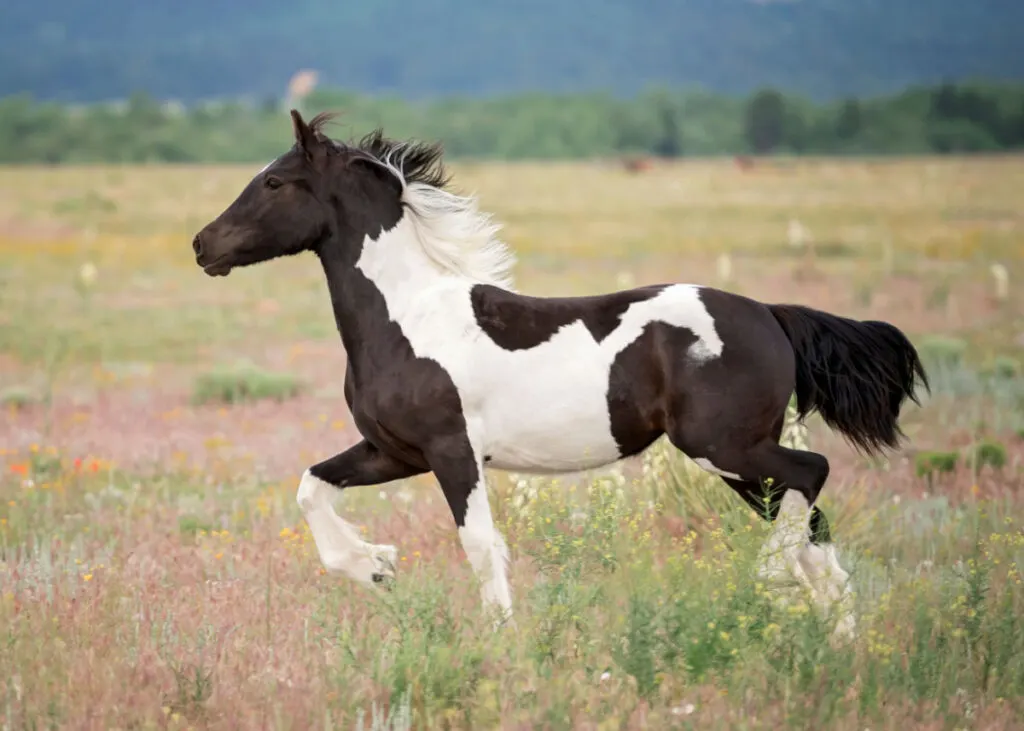
Known by many names, the Gypsy Vanner is an elegant carriage horse with a gentle disposition, and they often have unusual coat patterns that set them apart from other breeds. Keep reading to learn all about these majestic horses.
Table of Contents
A Horse With Many Names
Gypsy Vanner horses are known by many names – Irish Cob, Gypsy horse, or “colored cob” – to name a few.
In the US, the official breed title of “Gypsy Vanner” was invented by the American couple who imported the first members of the breed in the 1990s.
A horse who pulls the “Gypsy caravan” of a British or Irish Traveller is known as a “vanner horse” – hence the name Gypsy Vanner. (source)
The naming of the breed was done with the intention “to respect the spoken words of the Gypsy families who had dedicated lifetimes in the pursuit of developing and breeding the perfect caravan horse.” (source)
Technically, for a horse to be called a “Gypsy Vanner,” it must be registered with the American Gypsy Vanner Society.
Historically, pedigrees were passed down orally through the families who raised these unique horses, and breed information was not readily available to outsiders of the secretive caravan communities.
Gypsy Vanners can therefore be called many different things, particularly in the UK where they originated. Traditionally, they were referred to as the “Irish Cob” or simply “Cob,” although cob refers to a type of horse, rather than an actual breed. Here are some common alternate names for a Gypsy Vanner horse:
- Gypsy Horse
- Cob
- Gypsy Cob
- Gypsy Vanner
- Irish Cob
- Tinker Horse
- Coloured Cob
- Romany Horse
Though the Gypsy Vanner is mostly associated with both Irish Travellers and nomadic Romani people, these are ethnically distinct groups (but have similar cultural practices). (source)(source)
This breed became highly significant to these groups, and remains a special part of their culture to this day.
Breed History
Origins of the Caravan Horse
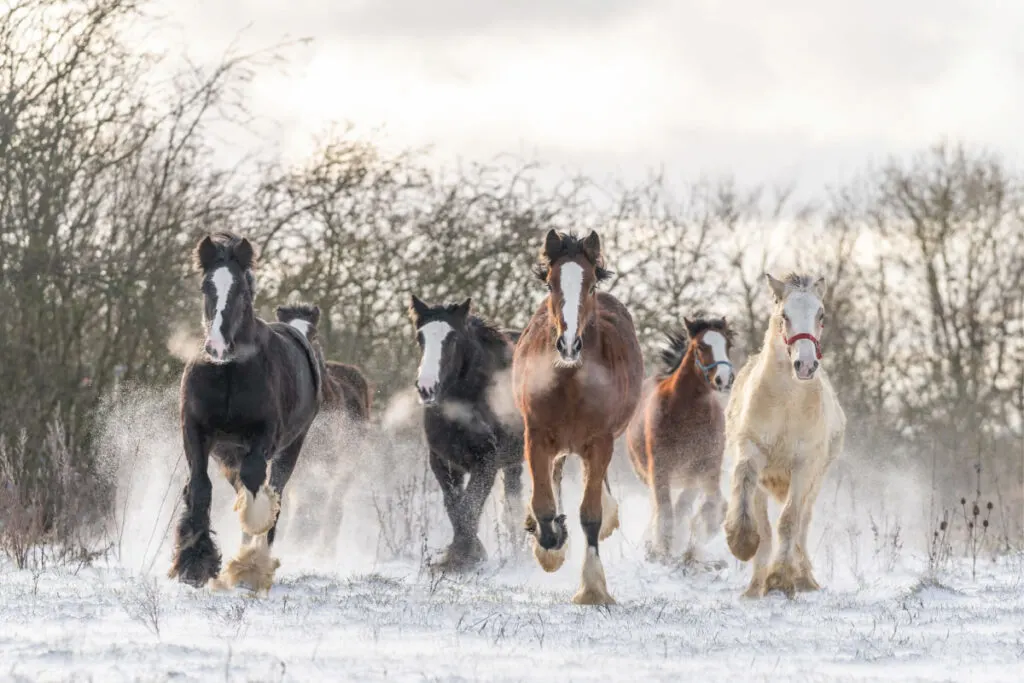
Throughout history, horses have been bred to pull carts and carriages, which gave people access to an efficient form of transportation. In the British Isles, groups of migratory people arrived from India in the 1500s. They traveled around the landscape, often working on farms in the growing season and selling goods door-to-door in the winter.
These iterant groups originally used cast-off cart horses or mules to pull their wagons, many of which were colorful Shire draft horses. Because piebald or skewbald horses were “unfashionable in mainstream society”, colored individuals were culled from horse populations and often picked up by these traveling groups.
The flashy coloring became popular with these travelers, who then began refining heavy draft horses to better suit their way of life in a caravan. While large horses are strong and docile, they require more sustenance and are more expensive to maintain than a smaller breed.
Romanichal Travelers began using horse-drawn vardos (elaborately decorated “living wagons”) as they lived and moved around the countryside. (source)
“From about 1850, traveling people in the British Isles began to use a distinct type of horse to pull their vardos, the caravans in which they had just begun to live and travel.”
(source)
Breeders began adding smaller horse breeds to their caravan horse bloodlines (which consisted of mostly Shire breeding at the time) – Hackney Pony, Welsh Cob, Friesian, Clydesdale, and eventually Dales and Fell Pony.
This created a smaller draft horse with a flashy knee action and a willing disposition. While there was no official record of these pedigrees, breeding records were kept orally by the people who bred and worked with these unique horses.
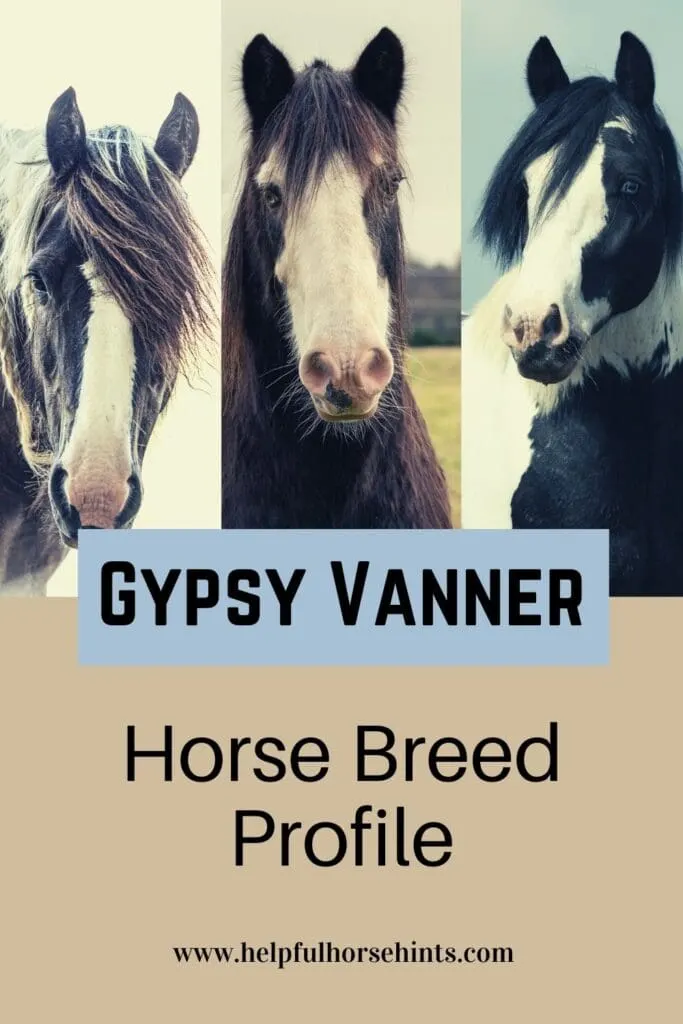
American Influence
Americans Dennis and Cindy Thompson traveled to England in the mid-90s on business. While touring the countryside, they discovered a beautiful black and white small draft horse with a flowing mane and tail. The horse, named Cushti Bok, belonged to a local Traveller family with a nearby caravan.
The Thompsons were enthralled with these mysterious horses, as there was little information about them outside of the Traveller communities. They dedicated the next few years to importing a herd of these horses to the United States, and introducing the majestic “Gypsy horse” to Americans.
Eventually, the Thompsons brought home Cushti Bok, another stallion named The Gypsy King, and 14 mares. In 1999, the first Gypsy horses were born on American soil, fully establishing the Gypsy Vanner breed. (source)
Global Spread
Today, there are many breed associations dedicated to preserving these unique horses, including the Gypsy Vanner Horse Society and Gypsy Horse Association in the US, and the Traditional Gypsy Cob Association in the UK (among several others).
Around the world, Gypsy Vanner enthusiasts began registering their own versions of these special horses, each with slightly different requirements.
Gypsy Vanner vs Gypsy Cob vs Drum Horse
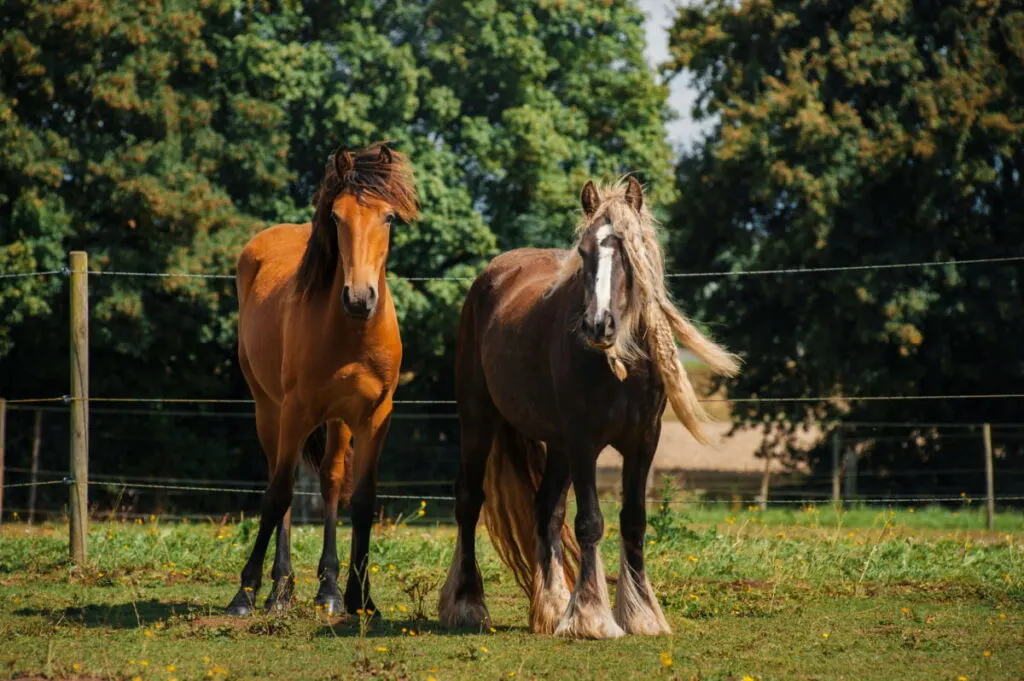
Simply put, a Gypsy Vanner is registered with the Gypsy Vanner Society.
In the US, Gypsy Cobs are registered with the GCDHA (Gypsy Cob and Drum Horse Association) and GCRA (Gypsy Horse Registry of America).
In the UK, Traditional Gypsy Cobs are divided into four categories according to height and use:
- Up to 14.2 hands tall – stocky pony, used for pulling carts.
- Up to 15 hands tall – strong cob-types, used for pulling full wagons or heavier loads.
- Over 15 hands tall – heavier draft-types, used for heavy wagons or agricultural work.
- Trotter – crossed with trotting breeds and raced in a sulky.
Drum Horses are a crossbreed combination of Shire, Clydesdale, and Gypsy Vanner. (source)
Breed Characteristics
Each breed association has different requirements for individual Gypsy Vanners. Overall, a Gypsy Vanner should be a small draft horse with “overall substance and bone”, significant feathering on the legs, and a flowing mane and tail.
They should be capable of pulling a heavy wagon, but also suitable for riding and not overly heavy. They must be kind, intelligent, tractable, and have an easygoing personality. (source)
Conformation
The breed standard of the Gypsy Vanner is that of proportion and presence. They should have a proud and noble appearance, and their bodies should be well-proportioned and correct.
- Head. Broad, flat forehead, large nostrils, expressive eyes.
- Neck. Well-proportioned, arched, and appropriately muscled.
- Body. Short, strong back, appropriate shoulder and hip angles, wide chest and well-sprung ribs, round “apple-bottom” croup and a high-set tail.
- Legs. Straight and correct, rear toes slightly turned out, heavy feathering is present.
Height
Actual height may vary, but most Gypsy Vanners are between 13.2 – 15.2 hands tall. They may be taller or shorter, as long as they have the other appropriate breed characteristics. They can weigh anywhere from 1,000 – 2,000 pounds, depending on breeding.
Movement
Gypsy Vanners are graceful movers with good knee-action, despite the influence of heavier draft horses in their breeding. They are balanced and graceful and have a presence both under saddle and in harness.
Color
Gypsy Vanners can be any color, but the “easily recognizable coat colors set the breed apart” from others. (source) They are often flashy in color, and present with piebald or skewbald coat patterns (they may also be solid, sabino, blagdon, or odd-colored).
Colorful horses were undesirable to mainstream horse breeders, and those horses were cast aside or culled.
British Travellers adopted piebald and skewbald horses as part of their culture, and the coat pattern became a prized asset for the breed. A horse with a unique coat pattern is easier to identify – which also means they’re harder to steal.
They were also less likely to be seized by the military, which protected them from the devastating effects that World War I had on other horse populations of Europe.
Temperament
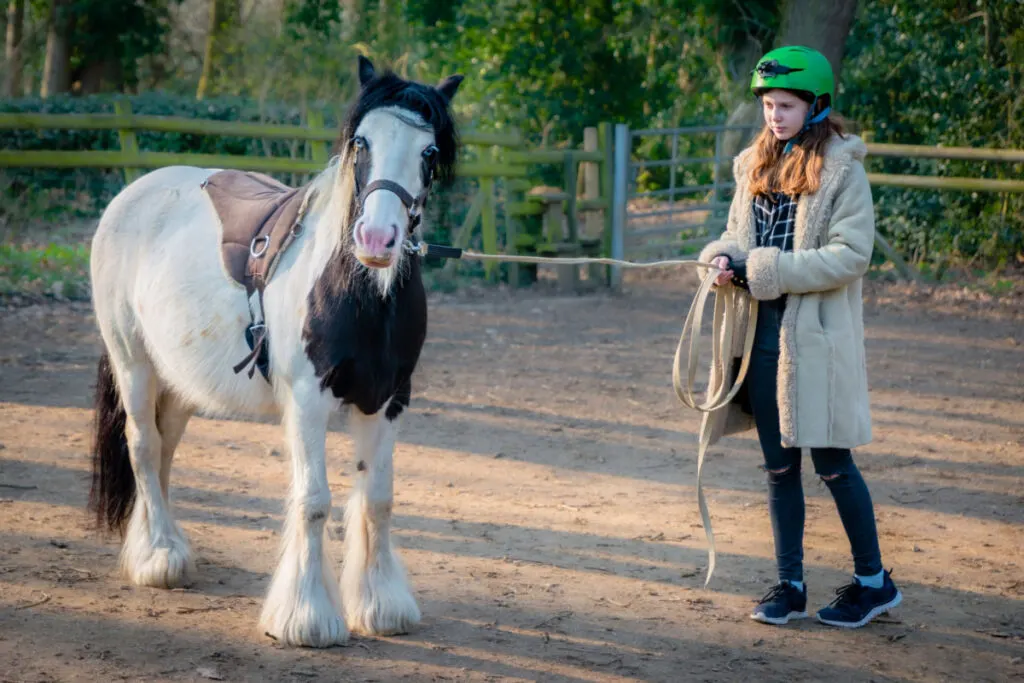
Because Gypsy Vanners lived closely with Traveller families, they had to be friendly and tractable. An aggressive or flighty carriage horse could pose a safety risk, and only the friendliest and easygoing horses remained.
Gypsy Vanners were bred to be safe around small children, and they are easily desensitized to the hustle and bustle of caravan life. They have the quiet disposition that comes from good draft horse breeding, but they are smaller and can be easier to handle than their larger counterparts.
Uses
Traditionally used to pull large wagons, these horses are excellent in harness. They are used recreationally or commercially to pull wagons and coaches, or competitively in the sport of combined driving.
Gypsy Vanners are also a popular choice for dressage, due to their elegant movement, stamina, and exceptional trainability. Because of their quiet temperaments, they can also be used for vaulting, trail riding, in parades, or for general pleasure riding.
Health
Designed to be hardy and easy keepers, Gypsy Vanners can live a long, healthy life of 25-30 years with few health issues.
Because they have feathering on the legs like other draft breeds, they can be prone to several specific health conditions such as Hyperkeratosis, Scratches, or Chronic Progressive Lymphedema.
With proper care and attention, most of these conditions can be managed without any long-lasting effects.
Because the genetic pool of purebred Gypsy Vanners is relatively small compared to other breeds, they can also carry the gene for Upward Fixation of the Patella (locked stifle or UFP) and Polysaccharide Storage Myopathy (PSSM).
A veterinarian can test the stifle joints for UFP, and potential owners should sure to ask the breeder about PSSM in their horses’ bloodlines. (source)
Cost
Because this breed is relatively new to the US, a purebred Gypsy Vanner can be quite expensive. A young untrained Gypsy Vanner with good bloodlines can cost anywhere from $5,000 – $15,000.
For a well-trained horse with show experience, expect to pay $10,000 – $20,000 (or more, depending on show record). These horses are often imported from the UK, which can increase the cost as well.
However, if pedigree is less important to you than finding the right match, you can find Gypsy Vanner crosses with a variety of different breeds for $3,000 – $5,000 on equinenow.com.
Is a Gypsy Vanner right for you?
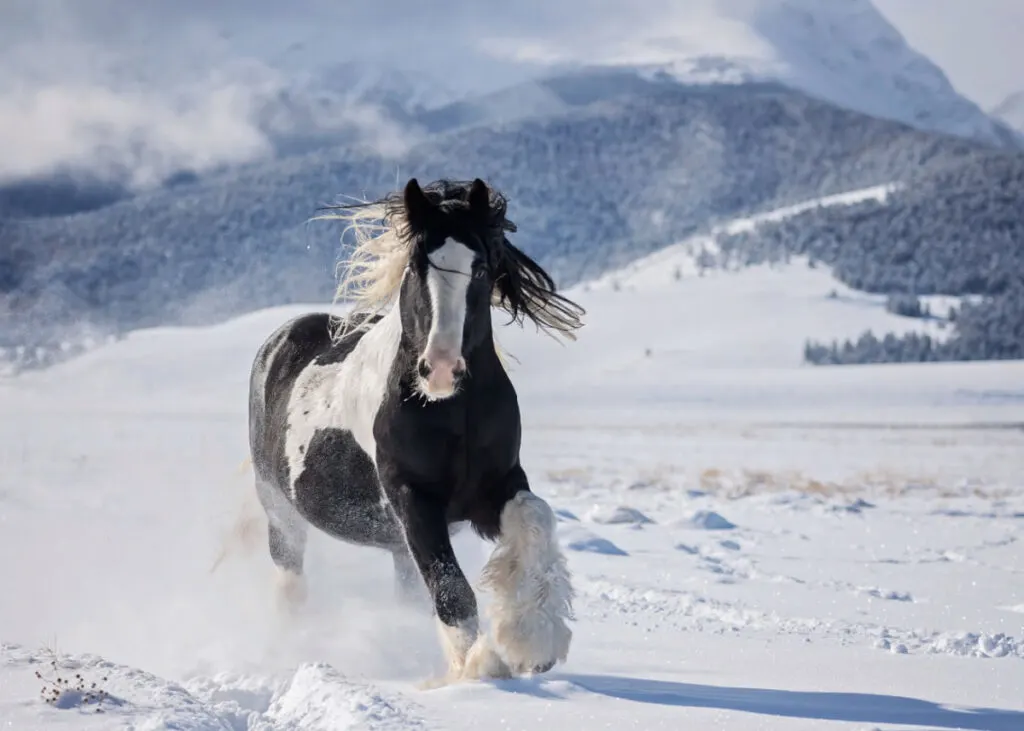
The Gypsy Vanner horse is beautiful, strong, and kind-hearted. They are good for beginners, as well as for experienced adults who are looking for a quiet, comfortable ride. They make excellent family horses, and can happily serve in a variety of disciplines.
However, a good Gypsy Vanner can be hard to find. They can be expensive to purchase, and their extra hair requires some maintenance and upkeep. If those things don’t deter you, then a beautiful colored “Gypsy horse” may be just the equine partner for you.
Resources
https://www.tgca.co.uk/about.htm

